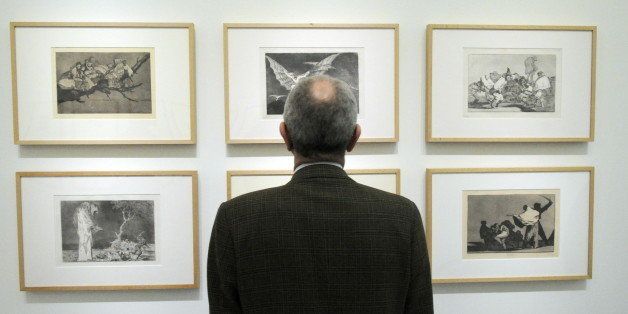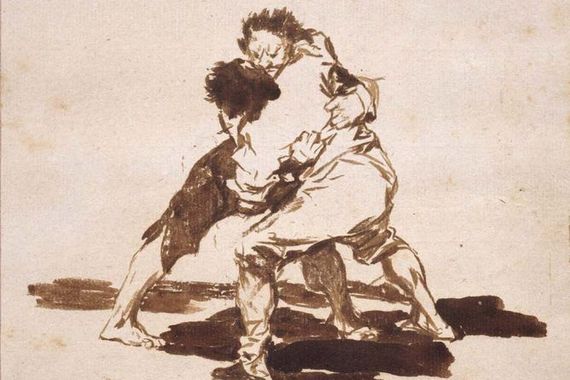
By Charles M. Sennott
BOSTON - The Spanish master Francisco Goya painted 200 years ago at a time not unlike the age of disruption, revolution, barbarity and torture that defined the year 2014.
The last 12 months have presented a descending darkness amid streaks of piercing light that feels straight out of one of Goya's canvases. Painting in the late 18th and early 19th centuries, Goya captured the tumult of the invasion and occupation of Spain by Napoleonic forces. He created searing scenes that seem strikingly relevant in 2014 as we look back on a year of darkness and light.
The darkness: ISIS and Boko Haram brought us to new depths while Russian President Vladimir Putin seems intent on returning Russia to the gray twilight of a retro, Cold War dictatorship.
The light: An agreement on climate change with China, a diplomatic opening with Cuba, immigration reform and an economic recovery that seems to be holding steady.
Framing the darkness and the light of 2014 was a wider struggle between the forces of "order" and "disorder." It's a dividing line between those governed by inclusive democracies and the ungoverned, where militias, tribes and extremists make up their own rules within failed states.
This idea of "order" versus "disorder" was even a theme of a series of columns by the New York Times' Thomas Friedman over the summer.
But Goya was way ahead of Friedman in helping us understand the moment in which we live. Indeed, the current exhibit at the Museum of Fine Arts in Boston, which frames the painter's life and his work, is even titled "Order and Disorder."
And Goya's work, particularly his fascination with 'disorder' and the fear and sorrow it engenders in everyday people, offers a prescient way to calibrate our own response to the 2014 news cycle.
The self-proclaimed Islamic State in Iraq and Syria (ISIS) brought us "disorder" and darkness with grotesque images of brutality. This year, ISIS came to embody the complex challenges that lie ahead for the US military as it tries to decode the dangers of rising Islamic militancy.
The year 2014 will also be remembered for the horrors of Nigeria's Boko Haram, in taking nearly 300 schoolgirls hostage, and the ghastly attack by the Pakistani Taliban on an army-run boys' school in Peshawar, which killed 132 children. And it will be remembered for the more invisible, antiseptic barbarity revealed by the US Senate Select Committee's investigation into the use of torture by the CIA.
For those of us at GlobalPost and The GroundTruth Project, 2014 will be remembered with great sadness as the year we saw our friend and colleague James Foley murdered by ISIS. He, along with two other American freelance journalists, was held at knife point by an ISIS leader and then decapitated while cameras rolled. These barbaric attacks were beamed out across the World Wide Web as some kind of perverse social networking, recruitment tool for ISIS.
This year will be remembered as a time when retro Cold War tensions came back into fashion, when Russian President Vladimir Putin decided to go from corrupt authoritarian to outright dictatorship, stumbling forward into the new year like one of Goya's frightening giants that stomp across the landscape.
It will also be recorded as a year when the forces of "order" failed in diplomacy. Secretary of State John Kerry dedicated himself to an extraordinary but ultimately fruitless effort to reach a break through in the deadlocked Israeli-Palestinian negotiations and in talks on Iran's nuclear program. Instead of progress, Iran walked away for a pause in talks and the Israelis and Palestinians watched as the conflict reached a new depth of tribalism and barbarity.
But for every hue of darkness there was in 2014, there seemed to come a contrasting streak of light trying to shine through.
President Obama announced an agreement with China to reduce greenhouse gasses. He announced an immigration reform package that seems to be rationalizing the US borders. And he set diplomatic relations with Cuba on a path to normalization after 50 years of a blockade that did little to effect any change for the people of Cuba. And through all of these positive developments, the economy also showed signs of flickering to life.
Back in 1808, Goya was seeing the same shades of darkness, and he was also searching for bands of light. He was witnessing the violent Spanish insurrection against occupation by Napoleonic forces. And he lived through the desperate famine that followed and sketched the thin faces of suffering.
Those experiences led to Goya's searing indictment of war and its horrors, captured in a collection of etchings that came to be called "The Disasters of War."
Through those years, Goya was a practitioner of "ground truth." One etching of women and children frozen in fear as they fled the onslaught of approaching troops, was succinctly titled: "Yo lo vi." Or, "I saw this."
These images of violence that Goya saw firsthand inspired his depictions of clumsy and ominous giants that stumble across war-torn landscapes.
Gruesome scenes of writhing bodies with severed heads and perversely detailed images of torture seem vivid commentaries on today.
After a visit to see Goya's work at the Prado Museum in Madrid, the legendary art critic Bernard Berenson remarked, "Here in Goya is the beginning of our modern anarchy."
And now, it seems, that anarchy is upon us.
But it is worth noting that the exhibit in Boston concludes with one of Goya's later works, the "Last Communion of Saint Joseph of Calasanz." The oil on canvas depicts an image of redemption for its subject, revealed through a beam of light that streaks down through the darkness.

